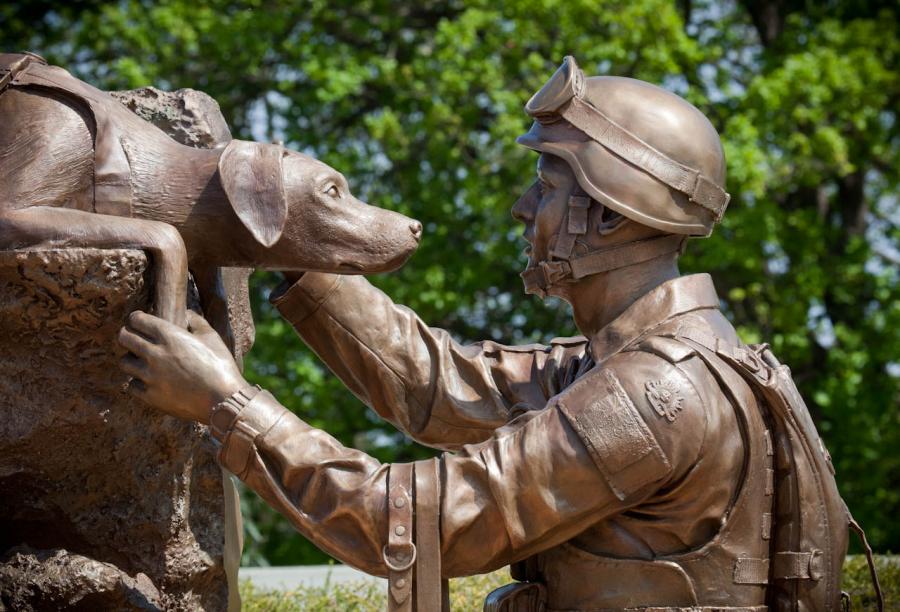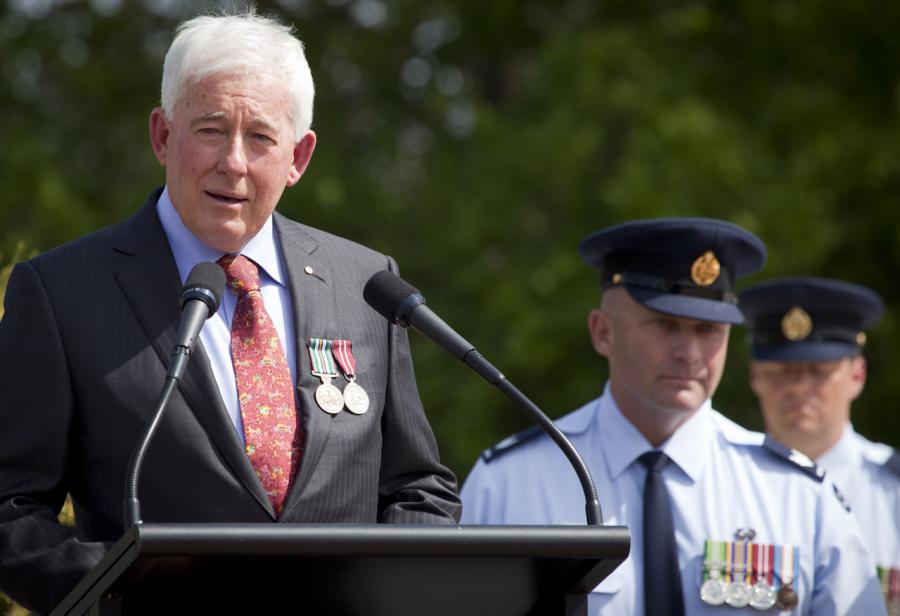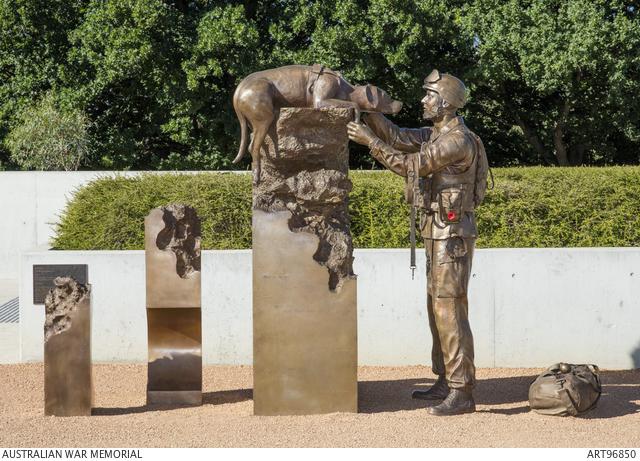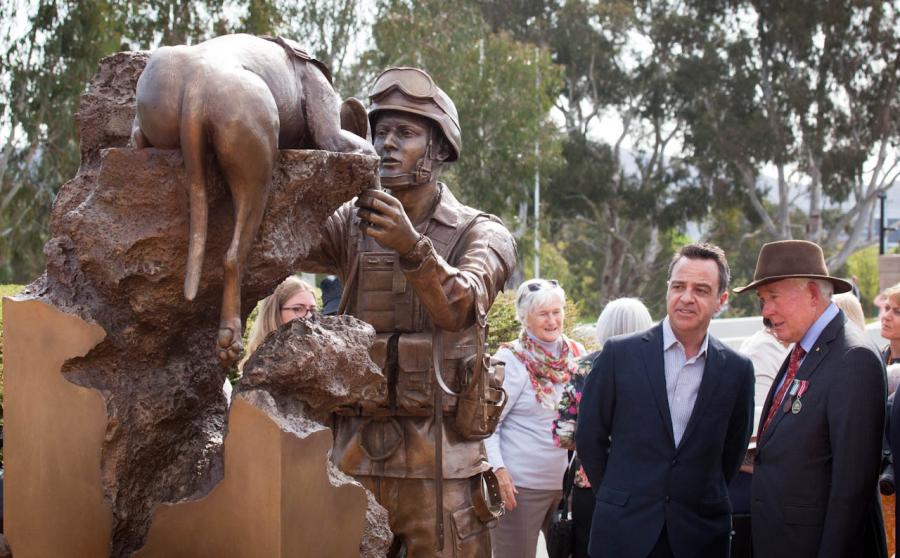'It’s about pride and gratitude for what others have done'

It’s the end of another long day in Iraq or Afghanistan, and an Australian sapper is helping his explosive detection dog out of its gear.
They are both tired after being out on patrol; the dog lying on top of a rocky outcrop, its back leg dangling, its eyes level with its handler’s.
Standing nose to nose, they are equals, looking lovingly into each other’s eyes as they prepare to take a well-earnt break and play a simple game of fetch.
It’s a special moment between a soldier and his dog, immortalised in a bronze sculpture, titled Elevation of the senses, at the Australian War Memorial.
Created by Melbourne-based sculptor and painter Ewen Coates, the sculpture was made possible thanks to the generosity of Doug Thompson, himself a dog lover and a veteran of national service.
“We wanted a memorial to show our thanks for what they did and still do in the wars in Iraq and Afghanistan,” Mr Thompson said. “When we got the design and Ewen came back with his ideas, we were so impressed; it exceeded everyone’s expectations, and I’m just so delighted and just so proud to have been associated with it.”

Doug Thompson speaking at the dedication ceremony in 2015.
Elevation of the senses commemorates the vital role and contribution of explosive detection dogs and their handlers in war. The tunnel through the base of the sculpture alludes to the rigorous training undertaken by the dogs, while the rocky outcrops atop the columns represent the foreign landscapes to which the dogs and their handlers are deployed. The elevation of the dog on the central column, where it crouches eye-to-eye with its handler, highlights the deep bonds that are forged between the two, as well as the mutual dependence on which their work is based.
Within the main column itself is a hidden cache of weapons, visible only from the back of the sculpture to illustrate the danger of buried IEDs or hidden weapons that the dogs find with their heightened sense of smell. Next to the pair is a duffel bag and a tennis ball, an integral part of the dog’s training, as well as a valuable reward when the animal has located explosives.
“Once you start reading about the bravery of these dogs, you realise they should be remembered, and sponsorship is a wonderful way for these things to be built,” Mr Thompson said. “I’ve got a red cattle dog and I would hate to be in the position where I could lose my dog, but that’s the reality they face every day.”

Working dogs were first used by the Royal Australian Engineers in 1918 when British dogs worked as messengers for Australian sappers in the trenches on the Western Front. The 1st Australian Dog Platoon, RAE, began to use search dogs during the Second World War, and Army Explosive Detection Dogs and their handlers have provided critical support to the Australian Defence Force and civilian government agencies in modern conflicts. Today, these dogs help save lives as they help their handlers find improvised explosive devices, ammunition, and weapons.
Inscribed on the side of the sculpture are the names of Australian explosive detection dogs that have been killed in operations – Merlin, Razz, Andy, Nova, Lucky and Herbie. There is also a human name – Sapper Darren Smith, who died with his beloved dog Herbie in Afghanistan in June 2010. Herbie, Darren, and Sapper Jacob Moreland were investigating metal signature on the footpad of a creek bed, when an IED was triggered. The blast killed Herbie, and mortally wounded Darren Smith and Jacob Moreland.
For Mr Thompson, it’s important to remember them.
“I don’t think we should ever forget the people who served,” Mr Thompson said. “It’s important for them to know that there are people here who are prepared to remember.”
Mr Thompson’s father, Walter, served in Borneo during the Second World War and his grandfather, James McClelland, was wounded on Gallipoli.
“It was just horrific,” he said. “He was wounded in the leg and saw the horrors of Gallipoli and Egypt … but he survived that, and in those days they were just discharged and told to get on with life.”
Each time he visits the Memorial, he pauses by the sculpture to reflect and remember.
“It makes you a better person just spending a day or two looking at the stories that are told at the Memorial,” he said. “As we are speaking today, we’ve got people being shot at in Afghanistan, and as we go about our daily lives … it’s easy to forget and lose track of that … but we shouldn’t.”

Doug Thompson, right, with artist Ewen Coates at the sculpture dedication.
He is passionate about the sculpture and the meaning behind it.
“I really love my dog, but I don’t depend on it every moment for my life,” he said.
“Their dog is their life and goodness knows how they feel when they lose them. How do you cope?
“I’ve got a couple of mates whose names are on the Roll of Honour … and it would be a very strange person who could walk away without wanting to do something.
“I’m just so proud to have my name against the sculpture: it’s not a statue in a park; it’s something more than that; and it means so much to people; it really is fantastic.”
His late wife Monique adored their dog Schatz – German for "sweetheart" – and cared deeply about remembering the explosive detection dogs and their handlers.
“[The sculpture] meant a huge amount to her,” he said.
“It’s about pride and gratitude for what others have done and is a living memory to those who served in Iraq and Afghanistan. I’m extremely proud, and it brings me so much pleasure to have been associated with the sculpture. I couldn’t recommend it highly enough.”
His late wife Monique was close to trainers at the Holsworthy army base and advised on the sculpture and its composition. She never got to see the finished work at the Memorial, but was given a photograph of it and how it would look. She was thrilled with the result and kept it by her bedside for the rest of her life.
The Australian War Memorial is honoured to partner with people like Mr Thompson to deliver projects like the Elevation of the senses sculpture. For information on how to be involved with the Memorial, contact giving@awm.gov.au